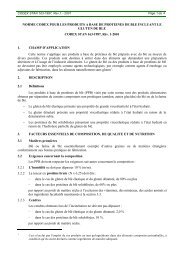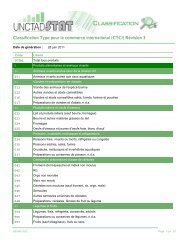issues and constraints related to the development of cashew nuts ...
issues and constraints related to the development of cashew nuts ...
issues and constraints related to the development of cashew nuts ...
Create successful ePaper yourself
Turn your PDF publications into a flip-book with our unique Google optimized e-Paper software.
18The fac<strong>to</strong>rs constraining production are derived from observations made during <strong>the</strong> undertaking<strong>of</strong> <strong>the</strong> two surveys. Once knowledge or a particular technology has been developed ei<strong>the</strong>r byresearch <strong>and</strong>/or by farmer groups, it is fur<strong>the</strong>r tested in on-farm trials. If proved successful, <strong>the</strong>results should be transferred <strong>to</strong> <strong>the</strong> largest possible number <strong>of</strong> future beneficiaries. Without agood level <strong>of</strong> farmer adoption, <strong>the</strong> knowledge or technology is wasted. In all <strong>of</strong> <strong>the</strong> countriessurveyed, <strong>the</strong> extension service for <strong>cashew</strong> farmers in most parts was:- Weak - extension personnel were present, but were not fully trained, with majorgaps in <strong>the</strong>ir knowledge, for example regarding identification <strong>and</strong> treatment <strong>of</strong>pests <strong>and</strong> diseases, or- Limited in manpower, transport <strong>and</strong>/or financial resources, or simply nonexistent.Extension is a very important, but also a very difficult <strong>and</strong> complex issue, especially whendealing with numerous <strong>and</strong> widely spread resource poor farmers. Many millions <strong>of</strong> dollars havebeen spent by countries taking loans from <strong>the</strong> World Bank <strong>to</strong> develop <strong>the</strong> Training <strong>and</strong> Visitsystem <strong>of</strong> extension, which is now thought by many <strong>to</strong> be inappropriate for resource poorfarmers, living <strong>and</strong> working in environments which are characterised by <strong>the</strong>ir complexity,diversity <strong>and</strong> risk proneness.The Training <strong>and</strong> Visit system is characterised by <strong>the</strong> following facts:- It is <strong>of</strong>ten expensive, <strong>and</strong> hence unsustainable in developing countries- It deals with “contact” farmers <strong>and</strong> <strong>the</strong> information is supposed <strong>to</strong> trickle down <strong>to</strong><strong>the</strong> vast majority <strong>of</strong> non-contact farmers, which <strong>of</strong> course it rarely does- It uses regimented “do this” <strong>and</strong> “do that” impact points, which are <strong>of</strong>ten notsuitable for <strong>the</strong> agro-ecological <strong>and</strong> socio-economic circumstances <strong>of</strong> <strong>the</strong>individual farmer.To help <strong>to</strong> overcome <strong>the</strong>se overwhelming problems, alternative approaches need <strong>to</strong> be tried, forexample:- A knowledge-based approach <strong>to</strong> extension, that has many benefits over simpleimpact points. It builds upon <strong>the</strong> existing knowledge <strong>of</strong> <strong>the</strong> farmer, <strong>to</strong> givehim/her a better underst<strong>and</strong>ing <strong>of</strong> <strong>the</strong> problem, so that existing <strong>and</strong> futuretechnologies can be adapted <strong>to</strong> suit his/her own agro-ecological <strong>and</strong> socioeconomiccircumstances.- Building <strong>and</strong> streng<strong>the</strong>ning farmer associations <strong>to</strong> act as focal points forextension activities- Training farmers <strong>the</strong>mselves as extension workers. These farmers would stillrequire regular supervision, <strong>to</strong> ensure that <strong>the</strong>y are not making mistakes <strong>and</strong>passing this on <strong>to</strong> o<strong>the</strong>rs.Farmer associationsFarmer associations in one form or ano<strong>the</strong>r were met in all countries visited, <strong>and</strong> most werereceiving no support at all. It is important that <strong>the</strong>se associations become successful <strong>and</strong> providetangible benefits <strong>to</strong> <strong>the</strong>ir members, especially <strong>the</strong> poorer ones. Not only do farmer associationspotentially benefit <strong>the</strong> farmer financially, by negotiating higher prices for outputs <strong>and</strong> lowerprices for inputs, <strong>the</strong>y are also very effective vehicles for knowledge <strong>and</strong> technology transfer <strong>and</strong>rural <strong>development</strong> in general. There is an urgent requirement for specialised input regardingfarmer associations. It appeared <strong>to</strong> <strong>the</strong> survey team that <strong>the</strong> bigger <strong>the</strong> association became, <strong>the</strong>less tangible were <strong>the</strong> benefits for <strong>the</strong> smaller farmer.


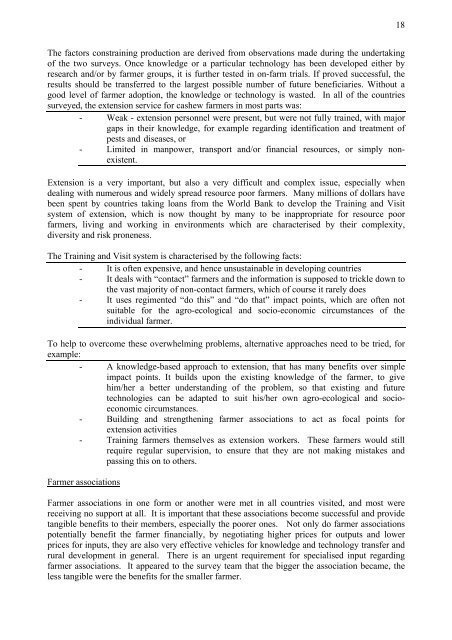
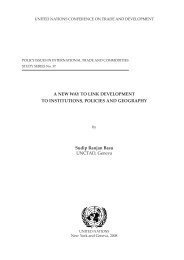
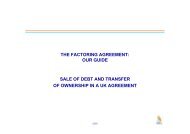

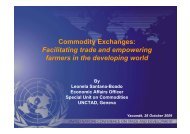
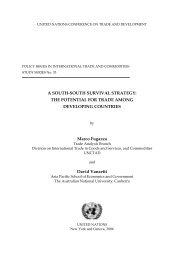

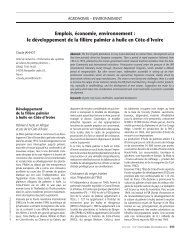


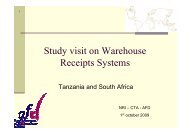
![Warehouse Receipt Systems: Legal Issues [PDF]](https://img.yumpu.com/43979338/1/190x134/warehouse-receipt-systems-legal-issues-pdf.jpg?quality=85)
